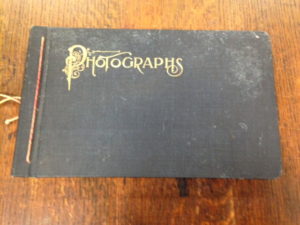
In the summer of 2015, the BVHS received an old photograph album from Arnold Robinson of Roger Williams University. It had been given to him by the children of the late Anne “Pete” Baker, a prominent preservationist architect. Since the pictures in the album related to Cumberland, he thought that researchers might find it more easily if it were in the Blackstone Valley. The list pictured here was tucked in the album. We are not sure if the original owners made the list. Someone had marked each picture in the album with a post-it note, naming each picture in order according to the list. There were several loose pictures in the back, of men perched on immense rocks. The same three men and a boy appeared in several of the pictures.

Oddly enough, most of the pictures seemed to be of abandoned houses, or at least houses in need of serious repair. The photographs of the Ballou Meeting House and the nearby cemetery were easily recognized.
A few months later, we saw a post by Diane Boumenot, in her blog called “One Rhode Island Family.” It was entitled “The Ballou Pioneer Settlers”. The post was about a booklet written by Col. Daniel R. Ballou for the Annual Meeting of the Ballou Family Association of America, held on September 5, 1914. It was called, “The Ballou Pioneer Setters of the Second Generation in the Louisquisset Country and How They Lived,” and explained how to find the houses of the earliest Ballous, who settled in what is now Lincoln, RI. Col. Daniel briefly touched on Maturin’s second son James, who purchased a large tract of land in Cumberland and divided it among three of his sons. Suddenly the album made sense. What if some Ballou descendants had decided to research the ancestral places of the Ballous in Cumberland? And one of them was a photographer?
The blog post included several illustrations from a vast Ballou Genealogy. “An Elaborate History and Genealogy of the Ballous in America,” by Adin Ballou, published in 1888, is a 1323 page tome about the descendants of Maturin Ballou. Two of the illustrations were nearly identical to the pictures in the album, and the album pictures were correctly identified according to the book.
We’ve been told that the clothing of the people in the pictures is from the early 20th century, around 1900.
Using “An Elaborate History and Genealogy of the Ballous in America” and 19th century maps, we set out to learn more about the photographs. This exhibit is about what we discovered. There is always more work to do. Sadly, we have not found any of the houses pictured still standing. Many of them were in poor condition when the photographs were taken. Perhaps this part of Cumberland was too remote and the farming unspectacular, and so, over time, they were abandoned.
The 19th century neighborhood documented in the photographs is lost: fourteen houses, a church, and even a road. However, the story of the houses and the people who lived in them intersects in a fascinating way with the history we learned in school: the Revolutionary War, the Dorr War, Samuel Slater and the rise of industrialization, abolition, the Civil War, even utopian communities. One of the descendants of the Ballous who lived here even became President of the United States.